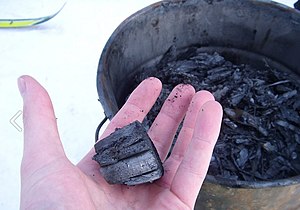biochar
 So you want to help the planet, do good things but can't seem to stop flying or having less kids? Try biochar - it's an ancient miracle addition to soil that just may be a tipping point for our very tired soil AND is the process reduces the need for one of the BIG BIG culprits in CO2 levels increasing. The majority most foods' carbon footprint is in the chemical fertilizers used to 'grow' the animals, fruits and vegies. While all the attention is on the bad boys of the fossil fuel industry the biggest polluter of them all - the chemical industry - is getting a pass. Our media considers this too boring to report on, since it won't sell more clicks, ads, or print.
So you want to help the planet, do good things but can't seem to stop flying or having less kids? Try biochar - it's an ancient miracle addition to soil that just may be a tipping point for our very tired soil AND is the process reduces the need for one of the BIG BIG culprits in CO2 levels increasing. The majority most foods' carbon footprint is in the chemical fertilizers used to 'grow' the animals, fruits and vegies. While all the attention is on the bad boys of the fossil fuel industry the biggest polluter of them all - the chemical industry - is getting a pass. Our media considers this too boring to report on, since it won't sell more clicks, ads, or print.So here's all you need to know about biochar: This is a new(?) miracle soil amendment that is rocking through farmlands around the globe - especially in the USA midwest.
Archeologists first discovered the concept of biochar when they unearthed some Aztec & Mayan ruins and found rich, nutrient filled soils around ancient sites. Using satellite imagery and google maps they soon discovered hundreds of these rich soil deposits.
-----------------------------------------------------------------------------------------------
 Biochar is charcoal used as a soil amendment. Biochar is a stable solid, rich in carbon, and can endure in soil for thousands of years.[1] Like most charcoal, biochar is made from biomass via pyrolysis. Biochar is under investigation as an approach to carbon sequestration,[1] as it has the potential to help mitigate climate change.[2][3][4] It results in processes related to pyrogenic carbon capture and storage (PyCCS).[5] Independently, biochar can increase soil fertility of acidic soils (low pH soils), increase agricultural productivity, and provide protection against some foliar and soil-borne diseases.[6] Regarding the definition from the production part, biochar is defined by the International Biochar Initiative as "The solid material obtained from the thermochemical conversion of biomass in an oxygen-limited environment".[7]
Biochar is charcoal used as a soil amendment. Biochar is a stable solid, rich in carbon, and can endure in soil for thousands of years.[1] Like most charcoal, biochar is made from biomass via pyrolysis. Biochar is under investigation as an approach to carbon sequestration,[1] as it has the potential to help mitigate climate change.[2][3][4] It results in processes related to pyrogenic carbon capture and storage (PyCCS).[5] Independently, biochar can increase soil fertility of acidic soils (low pH soils), increase agricultural productivity, and provide protection against some foliar and soil-borne diseases.[6] Regarding the definition from the production part, biochar is defined by the International Biochar Initiative as "The solid material obtained from the thermochemical conversion of biomass in an oxygen-limited environment".[7]I don't agree with the first statement tho. Biochar is not charcoal - it's way more than charcoal.
---------------------------------------------------------------------------------
how to make 'Poor man's biochar'
Next time you have a small fire, get a bucket of soil and when there are some good red
hot/white hot coals, add 2" of dirt on top of ALL the white-hot coals. Let it smolder for a couple days and walla! Don't touch it during this time, cuz it'll be hot. After a couple days you have biochar. You'll know its biochar if you see the shiny black surfaces, and it doesn't stain your hand with black dust like charcoal will. If that doesn't happen, then either the coals weren't hot enough or there wasn't enough soil.
What's happening here is that the soil is squelching the oxygen from the fire and kinda sequestering the carbon back into the briquets. It's a process called pyrolysis.
Before you apply the biochar to the soil, you'll have to activate it. First, break apart big pieces of biochar by whacking it with a shovel or hammer. to Activate these small pieces - some people add rock dust - but I don't like grinding rocks to fine powder or paying someone else to do that. I pour some manure tea ('chips' soaked in water +++) over the biochar and let it sit for a week. I mix biochar with coastal seaweed, fire place ashes, and deep forest peat. It's enriched my gardens for years and the worms love it!
-------------------------------------------------------------------------------------------
Links for further info:
youtube - search 'biochar'
wikipedia: https://en.wikipedia.org/wiki/Biochar
mother earth news: https://www.motherearthnews.com/organic-gardening/making-biochar-improve-soil-zmaz09fmzraw
Details of optimal activation of biochar.
https://pacificbiochar.com/pacific-biochar-biological-activation-process-to-improve-biochar/
-------------------------------------------------------------
sidenote: I first heard of biochar in 2002 when I attended the first biochar conference in the USA at Sonoma State University. It was also the premier viewing of 'symphony of the soil' - one of the best eco-movies ever! A sold-out crowd (over 500) was comprised mostly of Asians and South American farmers and researchers. Only a handful of Americans were present.

Comments
Post a Comment